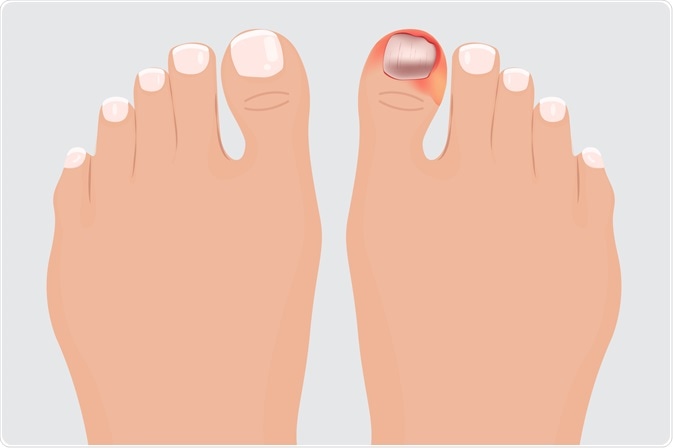The treatment of an ingrown toenail can usually be carried out at home, although some patients will require more specialized care.

Image Credit: Songtum Prakobtieng / Shutterstock.com
The primary aim of treatment is to prevent infection and allow the nail to grow back normally, away from the surrounding skin. In some cases, there may be the need for complete or partial removal of the toenail with a surgical procedure.
At-home care
In the majority of cases, ingrown toenails can be treated effectively in the home environment; however, some circumstances may require attention from a medical professional. In particular, patients should always be advised to seek medical attention if the skin has been pierced or there are signs of infection such as redness, inflammation, or pus. Additionally, anyone who also has diabetes, peripheral nerve damage, or poor blood circulation should seek medical advice immediately.
The at-home treatment of an ingrown toenail usually involves soaking of the feet in warm water 3-4 times a day. Gently massage the inflamed skin and then push the softened skin away from the edge of the toenail with a piece of cotton or dental floss, soaked with antiseptic.
Additionally, simple analgesic medications such as paracetamol or non-steroidal anti-inflammatory drugs (NSAIDs) can help to relieve any associated pain. Depending on the severity and depth of the ingrown toenail, a topical antibiotic may also be beneficial to prevent infection in the area.
Surgical therapy
In more severe cases, removal of the ingrown toenail with surgical procedures may be required.
Partial nail removal is a procedure that removes the section of the nail that has grown into the surrounding skin. A local anesthetic is used to numb the toe so that the nail can be narrowed and the part in the skin can be removed. This procedure cuts the edges straight and places cotton underneath the remaining nail to prevent the recurrence of an ingrown toenail. Phenol can also be used to hinder the growth of the nail, thus preventing a future ingrown toenail.
In some cases, it may be necessary to remove the entire toenail. This total nail removal procedure is best for individuals with thickened nails that caused the ingrown nail, as it is likely to recur. This involves an injection into the toe for local anesthesia, followed by the complete nail removal.
Following surgical removal of all or part of the affected toenail, the patient can usually return home with a bandage over the toe. It is best to rest as much as possible and keep the foot raised for 24 - 48 hours after the surgery.
On the second day, the bandage can be removed and open-toe footwear is advised. From this point, soaking the foot in salt water each day while also taking prophylactic antibiotics can help to prevent infection until the area heals. Analgesics medications can also be used to manage any pain if needed.
Prevention
There are several methods that can help to prevent future ingrown toenails, including:
- Cutting toenails straight across, rather than rounded
- Avoid cutting the toenails too short
- Wearing shoes, socks, and stockings that fit correctly
People with thickened or curved nails are more likely to suffer from toenails on a recurring basis. Often, surgical removal of the nail is the best option to prevent ingrowth.
References
Further Reading